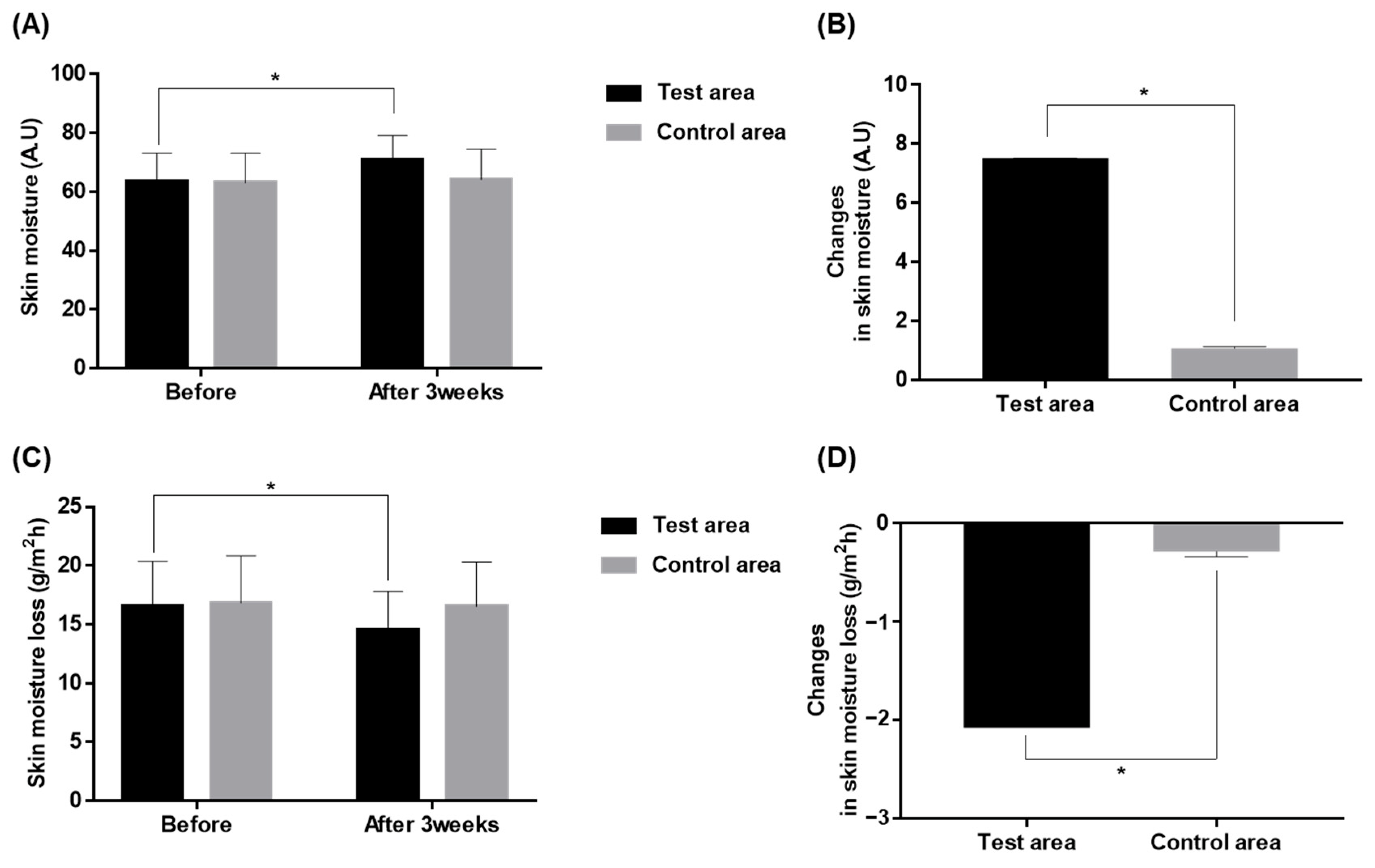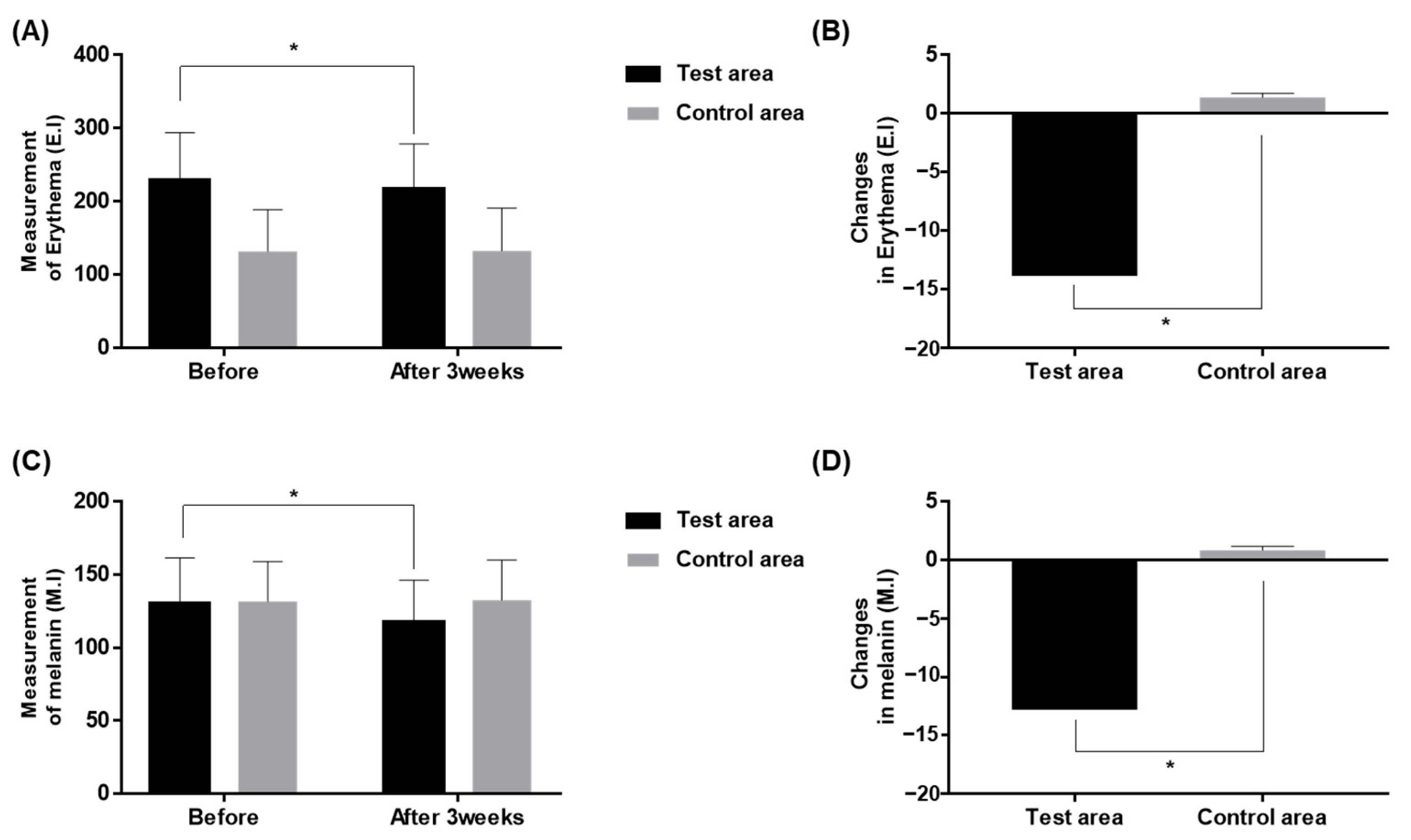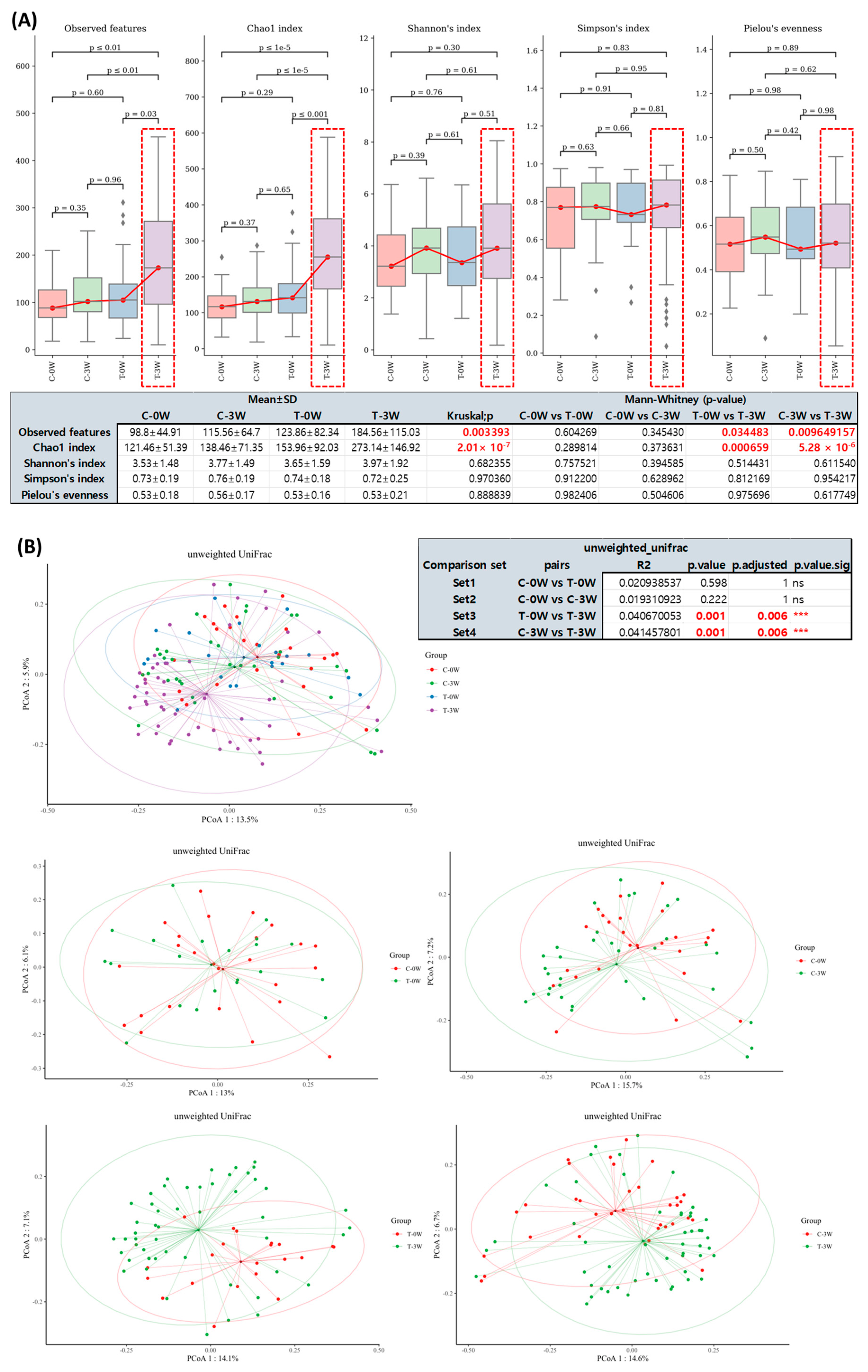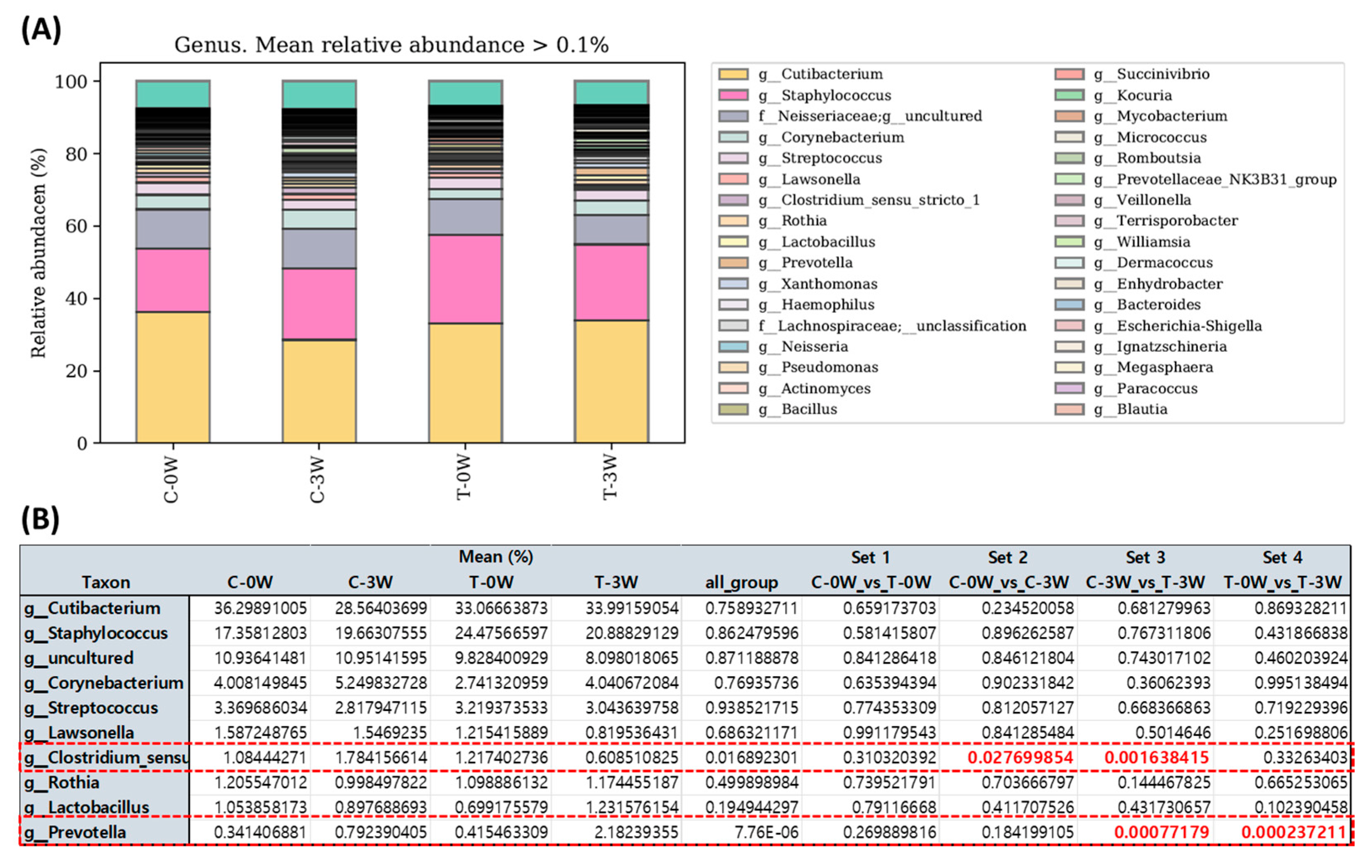Efficacy and Safety of Epidermidibacterium Keratini EPI-7 Derived Postbiotics in Skin Aging: A Prospective Clinical Study
Abstract
1. Introduction
2. Results
2.1. Participants’ Characteristics
2.2. Clinical Efficacy on Skin Hydration and Transepidermal Water Loss (TEWL)
2.3. Clinical Efficacy on Skin Elasticity and Dermal Density
2.4. Clinical Efficacy on Skin Erythema and Melanin Index
2.5. Effect on Skin Microbiome Diversity
2.6. Safety Profile
3. Discussion
4. Materials and Methods
4.1. Clinical Study
4.1.1. Ethics Statements
4.1.2. Study Participants
4.1.3. Study Design and Test Product Information
4.1.4. Assessment of the Clinical Efficacy of the Test Product
4.1.5. Assessment of the Safety of the Device
4.2. Microbiome Characterization
4.2.1. Microbiome Samples Collection from the Study Participants
4.2.2. Bacterial Genomic DNA Isolation
4.2.3. 16S V3-V4 Metagenome Sequencing
4.2.4. 16S Microbiome Data Analysis
4.3. Statistical Analysis
Author Contributions
Funding
Institutional Review Board Statement
Informed Consent Statement
Data Availability Statement
Acknowledgments
Conflicts of Interest
References
- Grice, E.A.; Segre, J.A. The skin microbiome. Nat. Rev. Microbiol. 2011, 9, 244–253. [Google Scholar] [CrossRef] [PubMed]
- Kong, H.H.; Grice, E.A.; Conlan, S.P.; Deming, C.; Young, A.C.; Bouffard, G.G.; Blakesley, R.W.; Green, E.D.; Murray, P.R.; Mijares, L.; et al. Diversity profile of the human skin microbiome. J. Investig. Dermatol. 2009, 129, S43. [Google Scholar]
- Norreslet, L.B.; Agner, T.; Clausen, M.L. The Skin Microbiome in Inflammatory Skin Diseases. Curr. Dermatol. Rep. 2020, 9, 141–151. [Google Scholar] [CrossRef]
- Werfel, T.; Glaser, R. A “hot” Topic: Skin Diseases and the Microbiome. Hautarzt 2019, 70, 398–399. [Google Scholar] [CrossRef] [PubMed]
- Kim, S.H.; Kim, J.H.; Suk, J.M.; Lee, Y.I.; Kim, J.; Lee, J.H.; Lee, K.H. Identification of skin aging biomarkers correlated with the biomechanical properties. Ski. Res. Technol. 2021, 27, 940–947. [Google Scholar] [CrossRef]
- Bascom, C.C.; Howard, B.; Hu, P.; Binder, R.L.; Fadayel, G.; Huggins, T.G.; Jarrold, B.B.; Osborne, R.; Rocchetta, H.L.; Swift, D.; et al. Aging-Associated Changes in the Adult Human Skin Microbiome and the Host Factors that Affect Skin Microbiome Composition. J. Investig. Dermatol. 2022, 142, 1934–1946. [Google Scholar] [CrossRef]
- Dimitriu, P.A.; Iker, B.; Malik, K.; Leung, H.; Mohn, W.W.; Hillebrand, G.G. New Insights into the Intrinsic and Extrinsic Factors That Shape the Human Skin Microbiome. MBio 2019, 10, e00839-19. [Google Scholar] [CrossRef]
- Juge, R.; Rouaud-Tinguely, P.; Breugnot, J.; Servaes, K.; Grimaldi, C.; Roth, M.P.; Coppin, H.; Closs, B. Shift in skin microbiota of Western European women across aging. J. Appl. Microbiol. 2018, 125, 907–916. [Google Scholar] [CrossRef]
- Shibagaki, N.; Suda, W.; Clavaud, C.; Bastien, P.; Takayasu, L.; Iioka, E.; Kurokawa, R.; Yamashita, N.; Hattori, Y.; Shindo, C.; et al. Aging-related changes in the diversity of women’s skin microbiomes associated with oral bacteria. Sci. Rep. 2017, 7, 10567. [Google Scholar] [CrossRef]
- Addae, A.J.; Zahr, A.S.; Jiang, L.I.; Desai, S.R.; Kononov, T. Clinical Study to Evaluate the Efficacy and Tolerability of Cosmeceuticals Targeting the Dermal-Epidermal Junction. J. Drugs Dermatol. 2021, 20, 1314–1321. [Google Scholar] [CrossRef]
- Carpio, L.E.; Sanz, Y.; Gozalbes, R.; Barigye, S.J. Computational strategies for the discovery of biological functions of health foods, nutraceuticals and cosmeceuticals: A review. Mol. Divers. 2021, 25, 1425–1438. [Google Scholar] [CrossRef] [PubMed]
- Lee, C.M. Fifty years of research and development of cosmeceuticals: A contemporary review. J. Cosmet. Dermatol. 2016, 15, 527–539. [Google Scholar] [CrossRef] [PubMed]
- Choi, H.; Kim, K.; Han, J.; Choi, H.; Jin, S.H.; Lee, E.K.; Shin, D.W.; Lee, T.R.; Lee, A.Y.; Noh, M. Kojic acid-induced IL-6 production in human keratinocytes plays a role in its anti-melanogenic activity in skin. J. Dermatol. Sci. 2012, 66, 207–215. [Google Scholar] [CrossRef] [PubMed]
- Gondran, C.; Bressier, G.; Perrin, A.; Marchand, T.; Bergeron, L.; Dal Farra, C.; Domloge, N. The whitening effect of Brassicaceae extract on the skin. Comparative studies with kojic acid. J. Investig. Dermatol. 2007, 127, S147. [Google Scholar]
- Huang, H.C.; Lee, I.J.; Huang, C.; Chang, T.M. Lactic Acid Bacteria and Lactic Acid for Skin Health and Melanogenesis Inhibition. Curr. Pharm. Biotechnol. 2020, 21, 566–577. [Google Scholar] [CrossRef]
- Jeong, J.H.; Lee, C.Y.; Chung, D.K. Probiotic Lactic Acid Bacteria and Skin Health. Crit. Rev. Food Sci. Nutr. 2016, 56, 2331–2337. [Google Scholar] [CrossRef]
- Liu, C.; Tseng, Y.P.; Chan, L.P.; Liang, C.H. The potential of Streptococcus thermophiles (TCI633) in the anti-aging. J. Cosmet. Derm. 2022, 21, 2635–2647. [Google Scholar] [CrossRef]
- Sanghvi, G.; Patel, H.; Vaishnav, D.; Oza, T.; Dave, G.; Kunjadia, P.; Sheth, N. A novel alkaline keratinase from Bacillus subtilis DP1 with potential utility in cosmetic formulation. Int. J. Biol. Macromol. 2016, 87, 256–262. [Google Scholar] [CrossRef]
- Boyajian, J.L.; Ghebretatios, M.; Schaly, S.; Islam, P.; Prakash, S. Microbiome and Human Aging: Probiotic and Prebiotic Potentials in Longevity, Skin Health and Cellular Senescence. Nutrients 2021, 13, 4550. [Google Scholar] [CrossRef]
- Ciardiello, T.; Pinto, D.; Marotta, L.; Giuliani, G.; Rinaldi, F. Effects of Fermented Oils on Alpha-Biodiversity and Relative Abundance of Cheek Resident Skin Microbiota. Cosmetics 2020, 7, 34. [Google Scholar] [CrossRef]
- Iglesia, S.; Kononov, T.; Zahr, A.S. A multi-functional anti-aging moisturizer maintains a diverse and balanced facial skin microbiome. J. Appl. Microbiol. 2022, 133, 1791–1799. [Google Scholar] [CrossRef]
- Lee, D.G.; Trujillo, M.E.; Kang, S.; Nam, J.J.; Kim, Y.J. Epidermidibacterium keratini gen. nov., sp nov., a member of the family Sporichthyaceae, isolated from keratin epidermis. Int. J. Syst. Evol. Microbiol. 2018, 68, 745–750. [Google Scholar] [CrossRef]
- Lee, Y.G.; Lee, D.G.; Gwag, J.E.; Kim, M.; Kim, M.; Kim, H.G.; Ko, J.H.; Yeo, H.; Kang, S.; Baek, N.I. A 1,1′-biuracil from Epidermidibacterium keratini EPI-7 shows anti-aging effects on human dermal fibroblasts. Appl. Biol. Chem. 2019, 62, 14. [Google Scholar] [CrossRef]
- Brosnan, M.E.; Brosnan, J.T. Orotic acid excretion and arginine metabolism. J. Nutr. 2007, 137, 1656S–1661S. [Google Scholar] [CrossRef] [PubMed]
- Loffler, M.; Carrey, E.A.; Zameitat, E. Orotate (orotic acid): An essential and versatile molecule. Nucl. Nucl. Nucleic Acids 2016, 35, 566–577. [Google Scholar] [CrossRef] [PubMed]
- Al Absi, H.S.; Sacharow, S.; Al Zein, N.; Al Shamsi, A.; Al Teneiji, A. Hereditary orotic aciduria (HOA): A novel uridine-5-monophosphate synthase (UMPS) mutation. Mol. Genet. Metab. Rep. 2021, 26, 100703. [Google Scholar] [CrossRef] [PubMed]
- Willis, A.D. Rarefaction, Alpha Diversity, and Statistics. Front. Microbiol. 2019, 10, 2407. [Google Scholar] [CrossRef] [PubMed]
- Callewaert, C.; Knodlseder, N.; Karoglan, A.; Guell, M.; Paetzold, B. Skin microbiome transplantation and manipulation: Current state of the art. Comput. Struct. Biotechnol. J. 2021, 19, 624–631. [Google Scholar] [CrossRef]
- Scott, E.; De Paepe, K.; Van de Wiele, T. Postbiotics and Their Health Modulatory Biomolecules. Biomolecules 2022, 12, 1640. [Google Scholar] [CrossRef]
- Coppola, S.; Avagliano, C.; Sacchi, A.; Laneri, S.; Calignano, A.; Voto, L.; Luzzetti, A.; Canani, R.B. Potential Clinical Applications of the Postbiotic Butyrate in Human Skin Diseases. Molecules 2022, 27, 1849. [Google Scholar] [CrossRef]
- Majeed, M.; Majeed, S.; Nagabhushanam, K.; Mundkur, L.; Rajalakshmi, H.R.; Shah, K.L.; Beede, K. Novel Topical Application of a Postbiotic, LactoSporin (R), in Mild to Moderate Acne: A Randomized, Comparative Clinical Study to Evaluate Its Efficacy, Tolerability and Safety (vol 7, 70, 2020). Cosmetics 2022, 9, 65. [Google Scholar] [CrossRef]
- Baldwin, H.E.; Bhatia, N.D.; Friedman, A.; Martin, R.; Seite, S. The Role of Cutaneous Microbiota Harmony in Maintaining a Functional Skin Barrier. J. Drugs Dermatol. 2017, 16, 12–18. [Google Scholar] [CrossRef] [PubMed]
- Di Marzio, L.; Cinque, B.; Cupelli, F.; De Simone, C.; Cifone, M.G.; Giuliani, M. Increase of skin-ceramide levels in aged subjects following a short-term topical application of bacterial sphingomyelinase from Streptococcus thermophilus. Int. J. Immunopathol. Pharmacol. 2008, 21, 137–143. [Google Scholar] [CrossRef] [PubMed]
- Keshari, S.; Balasubramaniam, A.; Myagmardoloonjin, B.; Herr, D.R.; Negari, I.P.; Huang, C.M. Butyric Acid from Probiotic Staphylococcus epidermidis in the Skin Microbiome Down-Regulates the Ultraviolet-Induced Pro-Inflammatory IL-6 Cytokine via Short-Chain Fatty Acid Receptor. Int. J. Mol. Sci. 2019, 20, 4477. [Google Scholar] [CrossRef] [PubMed]
- Chaiyasut, C.; Sivamaruthi, B.S.; Tansrisook, C.; Peerajan, S.; Chaiyasut, K.; Bharathi, M. Influence of Paraprobiotics-Containing Moisturizer on Skin Hydration and Microbiome: A Preliminary Study. Appl. Sci. 2022, 12, 12483. [Google Scholar] [CrossRef]





Disclaimer/Publisher’s Note: The statements, opinions and data contained in all publications are solely those of the individual author(s) and contributor(s) and not of MDPI and/or the editor(s). MDPI and/or the editor(s) disclaim responsibility for any injury to people or property resulting from any ideas, methods, instructions or products referred to in the content. |
© 2023 by the authors. Licensee MDPI, Basel, Switzerland. This article is an open access article distributed under the terms and conditions of the Creative Commons Attribution (CC BY) license (https://creativecommons.org/licenses/by/4.0/).
Share and Cite
Kim, J.; Lee, Y.I.; Mun, S.; Jeong, J.; Lee, D.-G.; Kim, M.; Jo, H.; Lee, S.; Han, K.; Lee, J.H. Efficacy and Safety of Epidermidibacterium Keratini EPI-7 Derived Postbiotics in Skin Aging: A Prospective Clinical Study. Int. J. Mol. Sci. 2023, 24, 4634. https://doi.org/10.3390/ijms24054634
Kim J, Lee YI, Mun S, Jeong J, Lee D-G, Kim M, Jo H, Lee S, Han K, Lee JH. Efficacy and Safety of Epidermidibacterium Keratini EPI-7 Derived Postbiotics in Skin Aging: A Prospective Clinical Study. International Journal of Molecular Sciences. 2023; 24(5):4634. https://doi.org/10.3390/ijms24054634
Chicago/Turabian StyleKim, Jihee, Young In Lee, Seyoung Mun, Jinuk Jeong, Dong-Geol Lee, Misun Kim, HyungWoo Jo, Sieun Lee, Kyudong Han, and Ju Hee Lee. 2023. "Efficacy and Safety of Epidermidibacterium Keratini EPI-7 Derived Postbiotics in Skin Aging: A Prospective Clinical Study" International Journal of Molecular Sciences 24, no. 5: 4634. https://doi.org/10.3390/ijms24054634
APA StyleKim, J., Lee, Y. I., Mun, S., Jeong, J., Lee, D.-G., Kim, M., Jo, H., Lee, S., Han, K., & Lee, J. H. (2023). Efficacy and Safety of Epidermidibacterium Keratini EPI-7 Derived Postbiotics in Skin Aging: A Prospective Clinical Study. International Journal of Molecular Sciences, 24(5), 4634. https://doi.org/10.3390/ijms24054634






